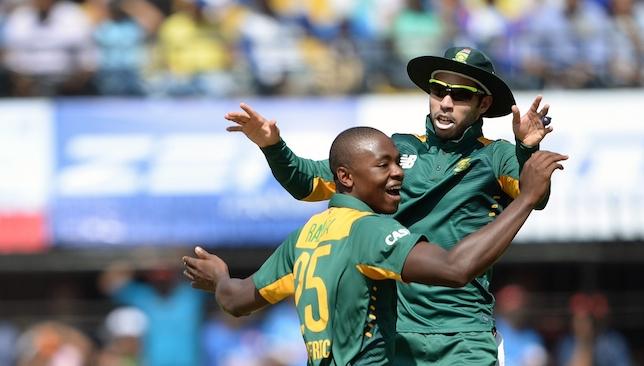
Fast bowlers are expected to do well in all conditions but very few manage to do so. Even fewer, from across the world, have conquered the unforgiving wickets of the Indian subcontinent.
– REPORT: Root stands firm with Pakistan on brink
– SLvWI: 2nd Test heading for draw after wash out
– Radio Cricket: MS Dhoni should be sacked
– #360view: Wahab proving to be Pakistan’s workhouse
Glenn McGrath, Andrew Flintoff, Dale Steyn and James Anderson come to mind while counting the handful of visiting quicks that have excelled there in the recent past.
The slow nature of its wickets makes fast bowling a backbreaking endeavour but those who master the art of variations in pace and reverse swing get to be hailed as truly special.
South African seamers have generally done well on Indian pitches. Lance Klusener, Fannie de Villiers and Steyn have bowled impressive spells and made a name for themselves. We can now add another name to that list.
Kagiso Rabada is only 20 but he is much wiser than his age suggests. His bowling during the ongoing India tour has been an absolute revelation and the sky is the limit for the supremely talented right arm pacer.
Rabada has all the attributes to become the next big fast bowling sensation. Endowed with great height and physique, the Johannesburg-born lad has an ability that very few possess – to bowl quick without seemingly trying to do so.
If you looked at a Shoaib Akhtar or a Mitchell Johnson coming in to bowl, you could see their intent was to simply blast the batsman out of his wits. Not with Rabada though.
Gliding in with the help of a smooth run up, the 20-year-old generates all the pace and bounce in the final few strides of his bowling making great use of his strong shoulders and quick arm action. His bouncer to opener Shikhar Dhawan in the deciding fifth ODI of the series was the perfect example of why he is different. Hurling the ball at 151kmph, Rabada zeroed in on helmet of Dhawan with fearsome accuracy.
And that’s what makes Rabada special. At such a young age, he can bowl wherever he wants without compromising on speed. He has not even played 20 first-class games and it doesn’t come as a surprise that the Proteas pushed him into the deep end of international cricket so early. He has already conquered the mechanics of bowling, which takes others years on the circuit.
World Cricket has found a new bowling star in Kagiso Rabada. #IndvSA
— Aakash Chopra (@cricketaakash) October 25, 2015
Rabada put his name on the cricketing map during last year’s U19 World Cup in the UAE, ending up as the second highest wicket-taker inthe tournament and helping the Proteas reach the final and then lift the trophy on the back of a sizzling six-wicket burst in the semi-final against Australia.
South Africans have never been known to rise to the occasion during final stages of a World Cup but Rabada helped them break that barrier, earning his country’s first ever World Cup final spot and later the title.
Now that we know that Rabada has it in him to become a great bowler, the challenges facing the South Africans change. The main target now is to keep him on course and see to it that flaws don’t creep into his bowling.
Rabada can’t be blamed if he wishes to bowl quicker and try more things with his bowling, that simply is the exuberance of youth. But he must be protected from the temptation of trying too many things at this stage of his career. His body will grow more and will reach its peak physical condition in the next five years.
What a bowler this young, 20 year old Rabada is! Will follow his career very closely now have become a huge admirer. #INDvSA
— Sanjay Manjrekar (@sanjaymanjrekar) October 25, 2015
Until that time, the South Africans must ensure that he is not over bowled and specific bowling plans are created for him to get the maximum out of him keeping a ten-year schedule in mind.
India quick Ishant Sharma also burst onto the scene as a teenager and had the world at his feet in his first year of international cricket. But he began to try too many things, lost his wrist position, his pace and spent the next five years getting his rhythm back. South Africa must take special care that Rabada doesn’t ruin his long term career in the pursuit of short-term success.
From bad to worse Cricketing relations between India and Pakistan have oscillated between frosty and breaking point over the past few years.
Attempts have been made to put some life into it but politics has played too big a role to make it possible. Sadly, the proposed series between the subcontinental giants in the UAE in December seems as good as over with talks between the boards failing to materialise.
The latest development in the messy saga is Pakistan Cricket Board chairman Shaharyar Khan’s threat of a pullout from the World T20 next year in India if the bilateral series doesn’t happen.
His warning comes on the back of anti-Pakistan protests by regional political party Shiv Sena in India. It is understandable if Pakistan doesn’t wish to send its team to India if it feels the players won’t be safe. But to link it with the bilateral series doesn’t make sense.
Pakistan should separate its World Cup ambitions from bilateral ones, otherwise they will end up losing on both fronts.